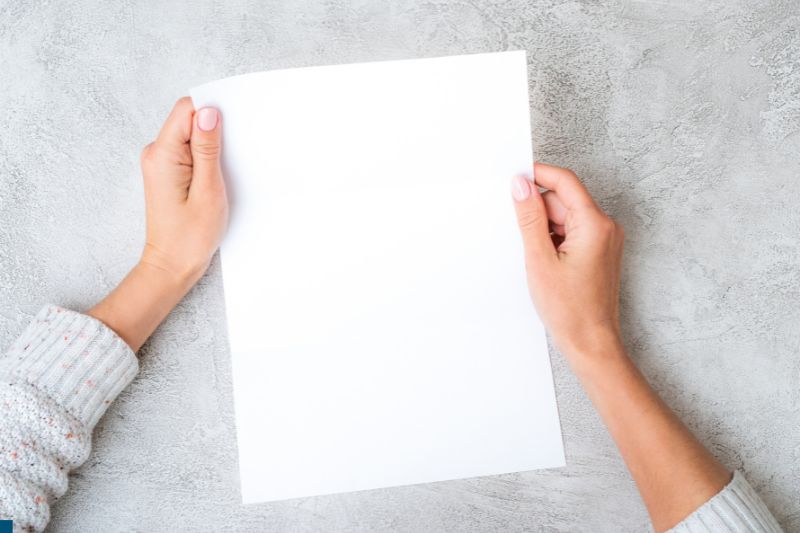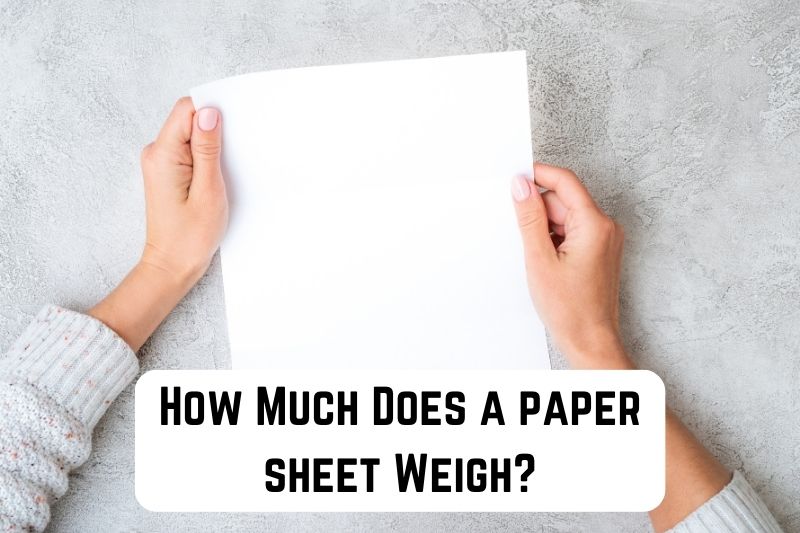Have you ever wondered how much a sheet of paper weighs? You might think it’s a trivial question, but knowing the weight of paper can be useful in various situations such as mailing letters, printing, or even understanding the environmental impact of using paper.
In this article, you’ll learn about the factors that determine the weight of a sheet of paper and how it can vary based on size, thickness, and material. By the end of your reading, you’ll better understand this everyday item that you might not have thought much to before.
Remember that the weight of a single sheet of paper can differ greatly, so it’s essential to consider these factors when learning about the weight of paper.
Read: How Much Does an Egg Weigh? Guide to Egg Sizes
An A4 paper standard basis weight is 80 gsm and measures 210mm x 297mm (8.27 x 11.69 inches) and weighs around 5gm (0.18 oz). So, a bundle of 500 sheets of A4 paper with each sheet weighing 5 gm will weigh around 2.5 kg.
Measuringly.com
How Much Does a Sheet of A4 Paper Weigh?
You might be curious about the weight of a single sheet of A4 paper. The weight of a paper can usually be determined by considering its basis weight. The basis weight is measured in grams per square meter (gsm) or pounds per ream (lb/ream).
In the case of A4 paper, the standard basis weight is 80gsm. This means that a square meter of this paper weighs 80 grams. To find the weight of a single A4 sheet, you’ll first need to determine its size.
A4 paper measures 210mm x 297mm (8.27 x 11.69 inches). To calculate its weight, you’d multiply these dimensions, yielding an area of 62,370 square millimeters (96.94 square inches). Since there are 1,000,000 square millimeters in a square meter, you’ll need to divide the result by 1,000,000.
- 62,370 square millimeters ÷ 1,000,000 = 0.06237 square meters
Now, multiply this number by the basis weight of 80gsm.
- 0.06237 square meters x 80gsm = 4.9896 grams
So, a single sheet of A4 paper typically weighs around 5 grams.
Remember that paper can also be found in different weights, ranging from lightweight (60gsm) to heavyweight (120gsm or more). A lighter paper weigh less than 5 grams per sheet, while a heavier paper weighs more.
I hope this helps you better understand the weight of a sheet of A4 paper! Remember that the weight can vary depending on the paper type and basis weight, but this should give you a good starting point.
Paper Types and Their Weights
There are several options for paper types, each with its own weight. This section will discuss standard office paper, cardstock and art paper.
Standard Office Paper
Standard office paper, also known as copy paper or printer paper, is what you are probably most familiar with. It is typically 20 lb or 24 lb (9.07 or 10.89 grams per sheet). These weights may also be 75 or 90 gsm (grams per square meter). A standard sheet of office paper measures 8.5 x 11 inches.
Below is a table with standard office paper weights and their GSM equivalents:
| Paper Weight (lb) | GSM Equivalent |
|---|---|
| 20 | 75 |
| 24 | 90 |
Cardstock
Cardstock, also known as cover stock, is a thicker and heavier type of paper. It is commonly used for business cards, greeting cards, invitations, and promotional material. The weight of cardstock ranges from 65 lb to 110 lb (176 to 300 gsm).
Here are some common cardstock weights and their GSM equivalents:
| Paper Weight (lb) | GSM Equivalent |
|---|---|
| 65 | 176 |
| 80 | 216 |
| 110 | 300 |
Art Paper
Art paper is designed for specific artistic uses, such as painting, drawing, or printmaking. The weight of art paper varies based on the specific type, but it is usually heavier than standard office paper. Watercolor paper, for example, typically ranges from 90 lb to 300 lb (245 to 810 gsm).
Some common art paper types and their weight ranges include:
- Watercolor paper: 90 lb to 300 lb (245 to 810 gsm)
- Drawing paper: 30 lb to 50 lb (110 to 184 gsm)
- Printmaking paper: 60 lb to 100 lb (90 to 270 gsm)
Remember that the paper’s weight affects its durability and how it will handle various mediums. Choosing the right paper for your project is important; understanding these different weights can help you make the best decision for your needs.
| Size | 75gsm | 80gsm | 90gsm | 100gsm | 110gsm | 120gsm | 160gsm |
|---|---|---|---|---|---|---|---|
| 4A0 | 300g | 320g | 360g | 400g | 440g | 480g | 640g |
| 2A0 | 150g | 160g | 180g | 200g | 220g | 240g | 320g |
| A0 | 75g | 80g | 90g | 100g | 110g | 120g | 160g |
| A1 | 37.5g | 40g | 45g | 50g | 55g | 60g | 80g |
| A2 | 18.75g | 20g | 22.5g | 25g | 27.5g | 30g | 40g |
| A3 | 9.38g | 10g | 11.25g | 12.5g | 13.75g | 15g | 20g |
| A4 | 4.69g | 5g | 5.63g | 6.25g | 6.88g | 7.5g | 10g |
| A5 | 2.34g | 2.5g | 2.81g | 3.13g | 3.44g | 3.75g | 5g |
| A6 | 1.17g | 1.25g | 1.41g | 1.56g | 1.72g | 1.88g | 2.5g |
| A7 | 0.59g | 0.63g | 0.70g | 0.78g | 0.86g | 0.94g | 1.25g |
| A8 | 0.29g | 0.31g | 0.35g | 0.39g | 0.43g | 0.47g | 0.63g |
| A9 | 0.15g | 0.16g | 0.18g | 0.20g | 0.21g | 0.23g | 0.31g |
| A10 | 0.07g | 0.08g | 0.09g | 0.10g | 0.11g | 0.12g | 0.16g |

Measuring Paper Weight
When you want to determine the weight of a sheet of paper, there are a couple of methods to consider. In this friendly guide, we’ll go through two key sub-sections: GSM and Pound Basis Weight and Calculating Weight per Sheet.
GSM
GSM stands for Grams per Square Meter, and it’s a popular method of measuring paper weight. Remember that a paper with a higher GSM value is thicker and heavier to understand GSM. For example, a standard copy paper usually has a GSM of 80, whereas a business card might have a GSM of around 300.
To measure GSM, you can use the following steps:
- Cut a piece of paper with dimensions of 1×1 meters.
- Weigh the paper using a precise scale.
- Record the weight in grams.
Pound Basis Weight
Pound Basis Weight is another method to determine paper weight, commonly used in the United States. Pound Basis Weight refers to the weight of 500 sheets (a ream) of paper in the parent size (before it is cut down to the final size).
Typical pound basis weight categories include:
- 20 lb: Standard copy paper
- 24 lb: Slightly heavier copy paper
- 32 lb: Premium paper, often used for resumes
- 65 lb: Cardstock paper
Calculating Weight per Sheet
To calculate the weight of a single sheet of paper, use the following steps:
- Determine the paper’s dimensions and weight per sheet (either GSM or Pound Basis Weight).
- Calculate the total area of the given sheet.
- If you’re working with GSM, multiply the GSM number by the paper’s area in square meters. If using Pound Basis Weight, divide the total weight of 500 sheets (in pounds) by 500 to get the individual sheet weight.
- Convert your result to the desired unit (grams, pounds, or ounces).
For example, if you have a 9×12-inch paper with a Pound Basis Weight of 20 lb, calculate the weight per sheet as follows:
- Determine paper dimensions: 9×12 inches.
- Calculate area: 108 square inches.
- Determine individual sheet weight: 20 lb (basis weight) / 500 = 0.04 lb per sheet.
- Convert to grams: 0.04 lb * 453.59 (grams in a pound) = 18.14 grams per sheet.
Factors Affecting the Weight of Paper
Paper Size
As you may know, paper size can greatly influence its weight. Several standardized paper sizes, such as A4, Letter, and Legal, differ in dimensions and weight. Here is a table to give you a general idea of how size affects weight:
| Paper Size | Dimensions (mm) | Approximate Weight (gsm) |
|---|---|---|
| A4 | 210 x 297 | 80 |
| Letter | 216 x 279 | 75 |
| Legal | 216 x 356 | 90 |
Remember that these weights are not fixed, as they can vary depending on the manufacturer and the specific type of paper being used.
Paper Coating
Another factor that can affect the weight of paper is its coating. Coatings are often applied to enhance a paper’s appearance, resist moisture and dirt, and improve printability. There are mainly two types of coatings:
- Gloss coating: This type of coating gives the paper a shiny and smooth surface, resulting in high-quality image reproduction. Glossy paper is typically heavier than other types due to the added layer of coating, which can influence its overall weight.
- Matte coating: Matte coated paper features a non-shiny, flat surface that is more resistant to fingerprints and smudges. It is generally lighter than glossy paper but still adds to the weight of the paper depending on the coating’s thickness.
Remember, these factors may vary based on the type of paper you’re using. Coatings and sizes are not the only factors affecting the weight of paper, but they are important when estimating the weight of a specific sheet.
Read: How Much Does a Generator Weigh: Guide to Common Models

Common Uses and Weight Recommendations
When you’re using paper for various projects, it’s important to consider the weight of the paper you’ll need. Lighter paper is great for everyday use, while heavier paper is generally recommended for more professional projects.
In this section, we’ll explore some common uses for different paper weights and provide recommendations for the appropriate paper weight you should choose for your needs.
Everyday printing and copying tasks at home or in the office typically call for lighter paper, such as 20-pound bond paper. This type of paper is suitable for general documents like invoices, reports, and internal memos. It’s also ideal for jotting down notes, creating drafts, and printing temporary materials.
For more formal projects, such as presentations and proposals, heavier paper weight is recommended. A 24-pound or 28-pound paper will give your documents a sturdier and more professional feel.
This weight range is perfect for double-sided printing and color presentations. The added thickness helps prevent ink from bleeding through, ensuring the highest quality appearance for your work.
When you’re creating marketing materials, such as brochures and flyers, consider using a 32-pound to 100-pound paper. The heavier weight gives these promotional products a higher-quality look and feel, and helps them withstand the wear and tear that comes with being passed around. Depending on your desired aesthetic, you can also opt for glossy or matte finishes.
For important documents like legal contracts, certificates, and resumes, a cardstock weight of 65-pound to 110-pound is ideal. This heavier paper conveys a sense of importance and professionalism, ensuring that your documents make a lasting impression.
Here’s a summary of weight recommendations for different common uses:
- General printing and copying: 20-pound paper
- Presentations and proposals: 24-pound to 28-pound paper
- Marketing materials: 32-pound to 100-pound paper
- Important documents: 65-pound to 110-pound cardstock
Remember, choosing the right paper weight for your project can significantly affect the final result. Remember these recommendations the next time you select paper for your printing needs.
Read: How Much Does a Fire Truck Weigh?
Environment and Usage of Paper
When considering the environment, it’s essential to note the impact of paper weight on resource consumption and waste production. A sheet of paper with a higher weight requires more pulp and water during production, thus increasing the demand for these resources. In contrast, lighter paper means less strain on environmental resources.
As you choose paper for your projects, remember that heavier paper may have a more upscale feel but could also lead to increased deforestation and water usage. Additionally, heavier paper produces more waste since disposal is typically determined by weight and volume.
On the positive side, several eco-friendly options are available for paper, which can help you minimize your environmental footprint:
- Recycled Paper: Using post-consumer waste reduces new resource consumption and saves energy and water during production.
- Sustainably sourced paper: Paper that adheres to sustainable forestry practices or holds certification (e.g., FSC) ensures responsible sourcing of raw materials.
- Alternative fibers: Paper made from alternative fibers like bamboo or hemp consumes fewer resources during growth and generates less waste.
When mailing documents, consider using lighter paper, reducing both shipping weight and associated carbon emissions. Furthermore, adopting digital solutions, such as sending electronic documents or using cloud storage whenever possible, can greatly reduce paper waste and strengthen our commitment to protecting the environment.







